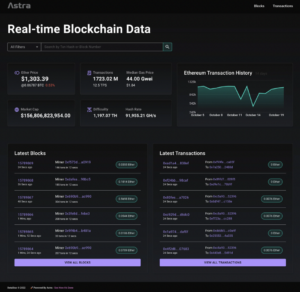DataStax is giving users of its AstraDB cloud service free access to entire blockchains, starting with Ethereum, with the goal of making it easier for developers to create new Web3 applications.
DataStax noticed that some of its customers were trying to host Ethereum themselves as part of crypto currency analytics offerings. Company saw the customers struggle to make it work, which is when they realized DataStax was in a position to alleviate a lot of administrative overhead by building support for Ethereum directly into the platform.
Astra Block, as the new service is called, is a feature available to all users of AstraDB, the Cassandra-database-as-a-service that DataStax originally launched back in 2019 (when it was called Constellation).
Currently, Astra Block hosts the entirety of Ethereum, which is the considered to be the largest blockchain, currently consisting of more than 1 TB of data, according to Alex Leventer, a Web3 developer at DataStax.
“It’s a heavy lift,” Leventer tells Datanami. “It’s especially a heavy lift for the real-time aspect. A lot of our users were running batch jobs, so the data is always out of date until you run the next job. So the real time aspect is hard to do. All the data modeling, all the management of the database–all that we’re taking care of for users.”
In addition to providing a copy of the blockchain, Astra Block exposes blockchain data via REST and GraphQL APIs or existing Cassandra drivers. The company has also built new indexes to speed up access to frequently used data.
The current state of blockchain development is not simple, and so the overarching goal with Astra Block is to simplify life for developers using the blockchain to build the next generation of Web3 applications, says Mike Hulme, vice president of marketing for the Santa Clara, California database and blockchain company.
“You’re asking developers to work with hundreds of API connections” without Astra Block, he says. “You’re asking them to build their own indexers. You’re having to manage their own infrastructure. And that’s taking away the time of actually building the app, delivering the app and doing the thing that’s valuable.”
A blockchain, of course, is a distributed ledger of transaction records stored in encrypted hashes. Blockchains are unalterable and open, features that enable them to form a trusted chain of record.
Crypto currencies such as Ethereum and Bitcoin use blockchains as the underlying technology that keeps everybody honest. The company plans to add support for additional blockchains in the future beyond Ethereum, including Bitcoin, Polygon, Solana, and Binance, DataStax officials say.
While cryptocurrency is the most visible application for blockchain technology, it’s not the only one. Many technologists have visions of using blockchains to displace institutions that currently function as the trusted middlemen in various industries, from finance and real estate to healthcare and entertainment.
Blockchain is still in its infancy in terms of adoption, but the upside for development of so-called Web3 applications is tremendous, Hulme says.
“We want developers of all skill sets to have access to this,” he says “So by giving them the flexibility of working in whatever language they want, using the right kind of APIs, using the right kind of models, they can actually bring their own skills to this thing that has really changed the way that applications are being built. We think that makes it much more accessible and we’ll give it broader appeal to some industries that maybe haven’t been able to take advantage of blockchain today.”
One company that’s currently developing Web3 applications on AstraDB is Blockscope. The Y Combinator company offers additional services on top of blockchains, including “no code” event listeners that monitor for transactions and events. When it detects an event of interest, it can trigger a webhook to take additional actions.
The future of blockchain has yet to be written, but DataStax wants to be part of the action, Hulme says.
“There’s a whole set of use cases that are coming out in different markets for blockchain. Crypto is the one that I think a lot of people associate with it, but we’re seeing a lot more interest around like healthcare or real estate for different types of transactions and historical data,” he says. “Cassandra is built for speed scale. There’s nothing that compares to it. And so when you’re working with data sets that are this large that have to be accessed in real time, there’s no better combination of technologies than Cassandra and blockchain.”
Related Items:
DataStax Bolsters Real-Time Machine Learning with Kaskada Buy
DataStax Nabs $115 Million to Help Build Real-Time Applications
DataStax Taps Pulsar for Streaming Data Platform
The post DataStax Adds Blockchain to Cloud NoSQL for Web3 Development appeared first on Datanami.


0 Commentaires